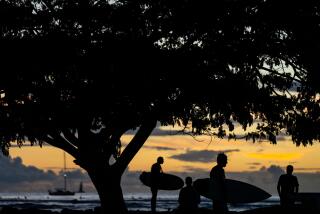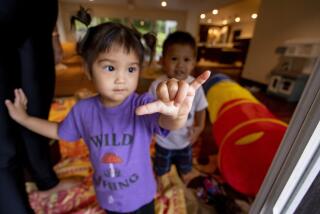Hula tells stories of repression, culture
- Share via
Bertolt Brecht’s dictum that art is not a mirror but a hammer came to mind at the Southern California premiere of the provocative dance theater piece “The Natives Are Restless” Friday night at the Carpenter Center.
Presented by the San Francisco-based hula troupe Na Lei Hulu I Ka Wekiu, “Natives” formed both mirror and hammer, reflecting the arrival of Calvinist missionaries to early 19th century Hawaii and smashing any sugarcoated notions about the deleterious consequences of the ensuing culture clash.
A pre-show voice-over of the Rev. Hiram Bingham’s 1820 account of the missionaries’ first sight of the islanders set the tone.
As such comments as “Can these be human beings?” cut through the darkened theater, the curtain opened onto a stunning scene of 23 elaborately “tattooed” bare-breasted women of all ages, shapes and sizes, sitting regally on stage.
Resplendent in crimson and gold skirts, they executed the sweet gestures of a welcoming arm hula with an effortless lyricism, the embodiment of grace and beauty.
Such disjuncture between the missionaries’ perceptions of the “devil’s nest” of hula and the audience’s appreciation for its refined, honeyed movements was a common ploy.
Company founder and choreographer Patrick Makuakane has a keen sense of manipulating the 33-member company. Gathering them in an initial portrait of invincibility, he syncopated the strong flexed gestures of the traditional (kahiko) style, performed by the men, with the smooth, fluid contemporary (auana) style, danced by alternating lines of women.
Makuakane’s innovative hula mua (literally “hula forward”) style, which pairs eclectic music sources with hula movement, effectively dramatized the violent conversion to Christianity in the gripping next section.
Set to the relentless techno rhythms of “Salva Mea,” the 1996 dance hit by the British band Faithless, dancers buttoned up tight in white long-sleeved shirts and black pants or full-length skirts huddled together, swept into kneeling formations or forcefully slapped themselves in rhythmic self-punishment. Makuakane made a gripping statement by contrasting a dance club classic usually used to set the body loose against the cast’s bold, sharply punctuated gestures and tightly restrained hip twitches.
Dressed in the flowing robes of the missionary, Makuakane acted as narrator as well as the embodiment of the fundamentalist’s fury. In a surprising moment of graphic enactment, he strode onstage at one point to violently wrench a woman from the group and mark her repeatedly with the sign of the cross, an action the group echoed by turning on one another in frenzied terror.
Like balm applied to a wound, the second half of the program featured acknowledged “happy hula” intermingled with Makuakane’s inviting conversational banter. Although suites such as the humorously titled “Reality Hula: The Extreme Grass Skirt Makeover” were aimed at debunking stereotypes of Hawaiian culture fostered by tourism and Hollywood, the enjoyable results were at striking odds with the first half.
Instead, such dances as a delicate trio set to opera or the “Firemen’s Hula” (featuring troupe members who are indeed firemen) seemed designed to showcase the skill of the company and the inventiveness of its visionary leader.
More to Read
The biggest entertainment stories
Get our big stories about Hollywood, film, television, music, arts, culture and more right in your inbox as soon as they publish.
You may occasionally receive promotional content from the Los Angeles Times.










